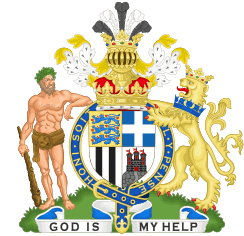Shepherd Neame Brewery
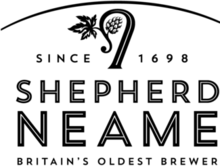 | |
| Industry | Alcoholic drinks |
|---|---|
| Founded | 1698 |
| Headquarters | Faversham, Kent, England |
| Products | Beer |
Production output | 211,000 imperial barrels (345,000 hl) (2016)[1] |
| Revenue | £139.9m (2016)[2] |
| Owner |
Jonathan Neame Chief Executive |
Number of employees | 1318[3] |
| Website |
shepherdneame |
Shepherd Neame is an English independent brewery founded in 1698 in Faversham, Kent, and family-owned since 1864.[4] The brewery produces a range of cask ales and filtered beers. Production is around 210,000 brewers' barrels a year.[5] It owns 328 pubs and hotels,[6] predominantly in Kent, London and South East England. The company exports to more than 35 countries including India, Sweden, Italy, Brazil and Canada.
History
The family of Neame were relative latecomers in the overall development of the Shepherd Neame Brewery but, as substantial property owners in the district, Charles Neame of Harefield Court and John Neame of Selling Court were acknowledged to be among the most valuable hop growers in East Kent. Theo Barker explains in the official account of the Brewery, that it all began with a Captain Richard Marsh who in 1678 is recorded in the Faversham Wardmote Books as contributing by far the largest of the ‘Brewers Fines’ made at that date.[7]
Shepherd Neame as such is reported as having been established in 1698, in an advertisement of the Kentish Gazette for 11 April 1865. Richard Marsh lived until 1727 when his Brewery was bequeathed to his widow, and then to his daughter, who sold the property on to Samuel Shepherd around 1741. Samuel Shepherd was from Deal, Kent. He had an interest in malting when he moved to Faversham around 1730 and had established himself as a Brewer of Malt by 1734. Shepherd expanded on his interest, through acquiring a number of public houses, but it was his son, Julius Shepherd, who extended this trend still further upon his inheritance of the Brewery in 1770, when the company held four such outlets. In 1789, he set about modernising the process of malt grinding and pumping, which had been previously worked with the employment of horses, by introducing what was reputed to be the first steam engine (Boulton and Watt) to be used for this purpose outside London, and was then able to describe his business as the Faversham Steam Brewery.
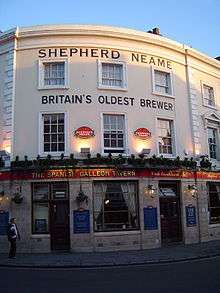
Henry, his second son, born in 1780, continued the family tradition, and raised his son of the same name into the business. It was this Henry Shepherd (1816~77) who was to be the last of the Shepherds actively involved in the Company. The death of Henry senior at the age of eighty-two occurred in 1862 and although his own son was not a businessman of the same determination, the firm’s expansion continued adequately with John Mares, who had come to the financial assistance of the Shepherd Brewery during the recession of the mid-1840s and continued as the impetus behind Shepherd and Mares until Percy Beale Neame joined the Brewery in 1864. Mares had seen the potential of the Brewery’s growth with the arrival of the long delayed railway service in 1858. He pressed the firm to actively prepare for such growth. Horse-drawn drays were used to carry the Brewery’s ales throughout Kent, and malts were imported by barge at Faversham Creek at its own wharf which was also used as the means to deliver its product to London, until the 1850s when steamboats were beginning to prove more expeditious to the task. The railways soon even outpaced and replaced the steamboats.
Mares' unexpected death at the age of 45 in 1864 placed Percy Neame, at the age of twenty-eight, as the stronger partner with Henry Shepherd, and with the challenge left to him in Mares' successful expansion programme he brought the Faversham Brewery well into the Neame family's dominion.
Shepherd Neame have embraced 21st-century brewing techniques, for instance using PDX Reactor Technology for the heat treatment of wort, rather than the traditional method, using a calandria. This has led to a reduction in energy consumption of 50%.[8]
Along with the Three Tuns Brewery in Shropshire, Shepherd Neame claims to the oldest brewery in the Great Britain. Three Tuns was licensed in 1642, 56 years earlier than Shepherd Neame. However, there is evidence that brewing has taken place on the Shepherd Neame site since at least 1573, over a century before the establishment of the current brewery.[9]
The brewery itself is located very near to Faversham town centre, and it is possible to smell the brewing processes regularly in the town and surrounding streets.
Beers
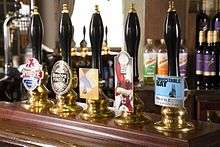
Shepherd Neame has been making beer in Faversham, Kent, for more than 500 years. It claims to use traditional methods and 100% natural ingredients.The brewery uses chalk-filtered mineral water from the brewery’s own artesian well, deep below the brewery, and 93% of the hops used in its beers are grown in Kent.[10] Centuries of brewing experience have been passed down to the current team of brewers, who still use many traditional methods, including handcrafting beer in the UK’s last remaining unlined solid oak mash tuns.
- Spitfire Premium Kentish Ale (cask: 4.2% abv, bottle: 4.5% abv) is Shepherd Neame's biggest-selling cask conditioned ale. . An infusion of three aromatic Kentish hops adorns this blood-orange tinted bitter, first brewed in 1990 to commemorate the 50th anniversary of the Battle of Britain in 1990.[11] The beer is named after the Supermarine Spitfire aircraft designed by R. J. Mitchell. Winner of a Gold Medal and Best Strong Cask-Conditioned Beer of the World at the Brewing Industry International Awards, Spitfire has Protected Geographical Indication, the same regional produce protection afforded to Champagne and Parma Ham.
- Bishop's Finger (cask: 5% abv, bottle: 5.4%abv) is a fine English Ale that takes its name from the Kentish nickname for an ancient signpost on the Pilgrims Way pointing to Canterbury and the shrine of Thomas Becket. The rich, ruby-coloured classic is one of the oldest names in British beer, brewed since 1958. Malt had been strictly rationed during the Second World War, and Bishops Finger was introduced as a celebration to the end of the postwar years of austerity. It has Protected Geographical Indication
- Master Brew (cask: 3.7% abv, bottle: 4%abv) is the Shepherd Neame's flagship beer. It is a distinctive, amber bitter ale, with a hoppy aroma. It has Protected Geographical Indication
- Brilliant Ale (cask: 4% abv, bottle: 5.6% abv) was first brewed between 1825 and 1855, and is believed to have been inspired by the early morning sun sending golden shafts of light through the brewhouse window on to the oak mash tun. Brewers decided to create a beer that echoed these hues, and used 100% pale malt and the East Kent Goldings hops to create a golden, brilliantly bright, hoppy ale. While staying true to the spirit of the popular pale ale, the modern incarnation has been rejuvenated by using the modern hop variety Cascade.
- India Pale Ale (cask: 4.5% abv, bottle 6.1% abv) hails from the tradition of 18th Century IPAs, which relied on generous hopping to protect exports during arduous journeys. This modern incarnation retains the strength, body and strong hop character which is synonymous with this beer's provenance. A glorious showcase of the distinct, heavily hopped beers for which Shepherd Neame is famed, India Pale Ale delivers potent bitterness, offset with generous amounts of pale ale malt to deliver a balanced, yet uncompromising brew.
- Double Stout (cask: 4.0% abv, bottle: 5.2% abv) is a black, creamy brew with a velvety-smooth palate of dry, burnt flavours, complemented by roast, cocoa and coffee notes.
- Mild (cask: 3.5% abv) is a dark beer with a complex aroma of dark chocolate, mocha coffee, vanilla and a smokiness reminiscent of autumn bonfires. The smooth, rich blend of chocolate and coffee is complemented by subtle hoppy, fruit flavours.
- Christmas Ale (cask 5% abv, bottle: 7% abv) is available during December. It is a full-bodied, warming winter ale, featuring a warming combination of fruits and spices. It combines pale and crystal malts with Target and Challenger hops for bitterness, and Goldings hops for aroma.
Seasonal beers:
- Amber Ale (cask 4.5% abv) is available from January to March. A golden brown beer perfect for winter, Amber Ale boasts a fruity aroma and a full, malty palate. It combines Pale, Crystal and Brown malts, bittered by English Challenger hops, with American Cascade hops added for aroma.
- Early Bird Spring Hop (cask: 4.3% abv, bottle: 4.5% abv) is available from March to May. A pale golden beer, with floral aroma, Early Bird is full-bodied and takes its name from the Early Bird variety of East Kent Goldings hops, grown in hop gardens near the brewery. It has been brewed by Shepherd Neame since the mid-1990s.
- Goldings Ale (cask 4.1% abv, bottle 4.5% abv) is available from June to September. The soft golden ale is made from Kentish First Gold and German Hersbrukker hops, dry hopped with Kentish Goldings grown in gardens close to the Faversham-based brewery. These citrusy hops are melded with the nutty, wholemeal character of crystal and ale malt to create a tangy, fresh finish.
- Queen Court Harvest Ale (cask 4.5% abv) is available from August to September. It is brewed every year to celebrate the start of the harvest across Kent’s hop gardens. It is named after Queen Court Farm at Ospringe near Faversham, the brewery’s former hop farm which houses the National Hop Collection, dedicated to the preservation of the UK’s hop-growing heritage and containing hundreds of rare varieties. The ale features pale and crystal malts and a mix of hops from across the globe to reflect the huge range of varieties available to modern brewers. It is bittered with Kentish First Gold, before German Hersbrucker is added as a late copper hop and a blend of UK Cascade and US Centennial are added as dry hops in cask.
- Late Red Autumn Hop Ale (cask 4.5% abv) is available from September to December. The crimson copper-coloured seasonal ale is a complex, full flavoured brew, forging the perfect balance between rich, dark malt flavours and a citrussy hop finish. It blends pale ale malt and gently-kilned crystal malt with UK Cascade and Goldings hops. To enhance its taste and aroma, the brew is triple-hopped, with a late copper addition of Goldings and Cascade.
Shepherd Neame has created a range of innovative limited edition beers under its No.18 Yard Brewhouse brand, using experimental brewing ingredients.
- Dragonfire (cask 4.5% abv) is available from April to May. It was created to commemorate St George’s Day, and combines barley, oats, rye and wheat with two English hop varieties – Goldings and First Gold – in addition to a fiery secret ingredient. It is full bodied and rich with a mellow mahogany hue.
- 4-4-2 (cask 4.0% abv) is available from June to July, and is named after the England side’s favoured football formation, as it has its own special line-up, in the form of 10 different hop varieties. They are melded with crystal and ale malt to create a delicious, full bodied brew which is pale in colour.
- Tallyman’s Special (cask 4.5% abv) is brewed by Shepherd Neame every year for the Kent Green Hop Beer Fortnight at the end of September. Instead of the usual dried hops, the brew uses fresh green hops and showcases the full array of esters and aromas usually lost in the drying process.
- Spooks Ale (cask 4.7% abv) is available from October to November. It describes itself as The Official Ghost Brew of All Hallows, and is appropriately a dark ruby colour. It boasts a biscuity palate created by a trio of Pale, Crystal, Brown and Chocolate malts, with bitterness provided by Target hops and a citrus aroma from Styrian Goldings.
- Rudolph’s Reward (3.7% abv) is available during December. A crisp, light winter beer, it combines pale and crystal malts with Target and East Kent Goldings hops, with mulled wine spices added at the end of the brew.
Whitstable Bay collection: Shepherd Neame originally adopted the Faversham Steam Brewery moniker in the late 18th century when it became one of the first steam-powered breweries outside London. The brewery bought a five horse power engine from steam pioneers Boulton and Watt which powered all processes on site, pairing the revolutionary machinery with the finest local ingredients to create exceptional beers. It has now revived the title to reflect the traditional provenance of the Whitstable Bay collection.
- Whitstable Bay Organic Ale (bottle: 4.5% abv) is a light-coloured ale brewed using only organic ingredients, including organic Tradition or Challenger hops, organic Ale and Crystal malts and the brewery’s own chalk-filtered mineral water, also certified organic. It combines delicate hints of fresh hops with the softer, buttery richness of pale and crystal malts.
- Whitstable Bay Pale Ale (draught: 3.9% abv, bottle: 4% abv) is a light-coloured, thirst quenching beer is brewed with the Challenger and Styrian Goldings hops, and Ale and Crystal malts. The sweet maltiness balances perfectly with the fresh pine notes provided by the hops added late in the process.
See also Whitstable Bay Black Oyster Stout and Whitstable Bay Blonde Lager under Keg.
Keg: Shepherd Neame produces brewery-conditioned draught beers which are brewed in exactly the same way as traditional, cask beers but filtered before being packaged into pressurised kegs. This ensures consistency of taste, and is the preferred option in bars where there is limited, or no, cellar space.
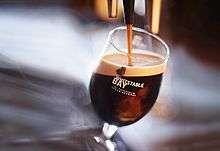
- Whitstable Bay Black Oyster Stout (draught 4.2% abv), is a silky keg stout brewed using a unique blend of four coloured malts which impart a rich, complex flavour of roasted mocha notes, balanced by a subtly bitterness from the finest Admiral hops, and finished with a smooth, creamy head.
- Whitstable Bay Blonde Lager (draught: 4.5% abv, bottle: 4.5% abv) takes its name from the golden hue of the beer. It is brewed with Challenger, Centennial and Saaz hops, and Lager and Crystal Malts. It has a floral aroma, paired with buttery biscuit base notes and crisp, citrus flavours.
Bottled: In addition to the bottled versions of some of its most popular beers such as Spitfire and Bishops Finger, Shepherd Neame also produces some beers in bottle only.
1698 Bottle Conditioned Kentish Strong Ale (bottle 6.5% abv). First brewed in 1998 to celebrate Shepherd Neame's tercentenary, 1698 is thrice hopped and bottle conditioned. A silver medal winner in the Taste of Britain Awards, 1698 has been included in the International Beer Challenge's World's Top 50 Beers and has won a Gold Award from the British Bottlers' Institute. It has Protected Geographical Indication, the same regional produce protection afforded to Champagne and Parma Ham.
Lager: The brewery also produces a range of lagers, mainly under licence, such as Samuel Adams Boston Lager, Holsten Export, Oranjeboom and Kingfisher, but also Hürlimann Sternbrau Lager: Export Bier [330 ml or 500 ml Bottle, 500 ml can, or draft keg; 4.8% ABV]. Shepherd Neame manufactures this beer in Britain and exports it to Europe. A bock style beer is also brewed. These are served on draught in the brewery's pubs and receive more frontage than non-brewery brands.
Pubs
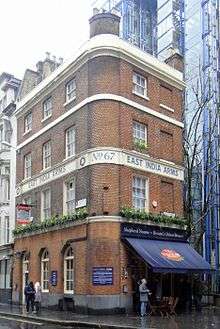
The brewery owns around 330 pubs and establishments, mostly in Kent, but extending across the South East of England. These are predominantly tenanted public houses situated in towns and villages. The brewery also manages its own chain of hotels, including The Royal Albion in Broadstairs and The George Hotel in Cranbrook, Kent. The brewery's own brands are typically given prominence in terms of frontage with extensive branding. All fonts and pumps bear the distinctive logos and branding, glasses are branded and bar runners that advertise the house beers are commonplace.
See also
References
- ↑ "Shepherd Neame Preliminary Results Release 2016" (PDF). shepherdneame.co.uk. Retrieved 21 September 2016.
- ↑ "Shepherd Neame Annual Report 2016" (PDF). shepherdneame.co.uk. Retrieved 21 September 2016.
- ↑ "Shepherd Neame Annual Report 2016" (PDF). shepherdneame.co.uk. Retrieved 21 September 2016.
- ↑ McFarland, Ben (2009). World's Best Beers: One Thousand Craft Brews from Cask to Glass. Sterling Publishing Company, Inc. p. 85. ISBN 9781402766947.
- ↑ "Shepherd Neame Preliminary Results Release 2016" (PDF). shepherdneame.co.uk. Retrieved 21 September 2016.
- ↑ "Shepherd Neame Annual Report 2016" (PDF). shepherdneame.co.uk. Retrieved 21 September 2016.
- ↑ "Shepherd Neame : A Story that's been brewing for 300 years" Theo Barker (1998) Granta Editions, Cambridge and Shepherd Neame: Faversham, Kent
- ↑ PDX Reactor technology
- ↑ "History of Shepherd Neame". www.faversham.org. Retrieved 2008-05-30.
- ↑ MorningAdvertiser.co.uk. "Hops shortage in States sparks plea for brewers to buy British". morningadvertiser.co.uk. Retrieved 24 August 2016.
- ↑ "Spitfire Premium Kentish Ale: Spitfire The Beer". www.spitfireale.co.uk. Retrieved 2011-03-22.
Bibliography
- "Bottle of Britain Campaign" (1997–2005)

.svg.png)
